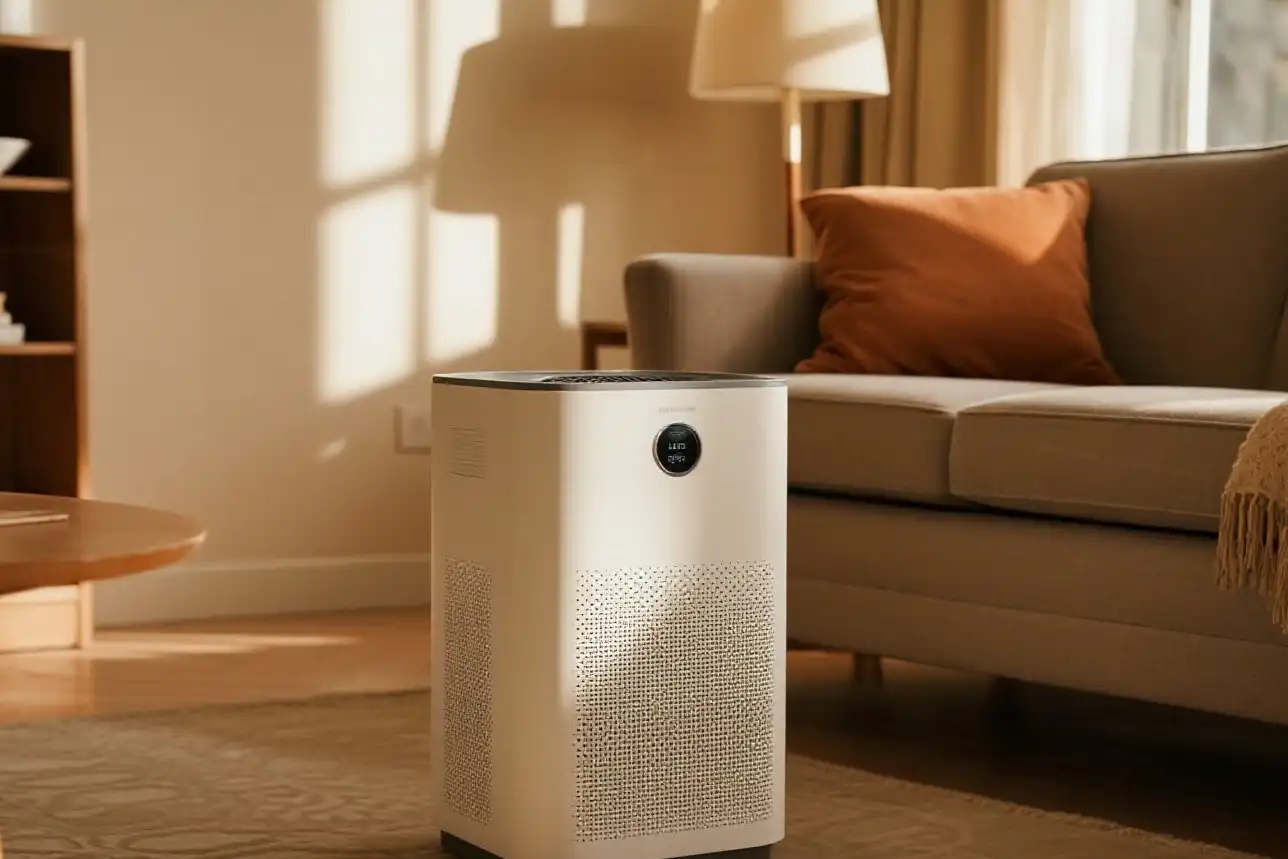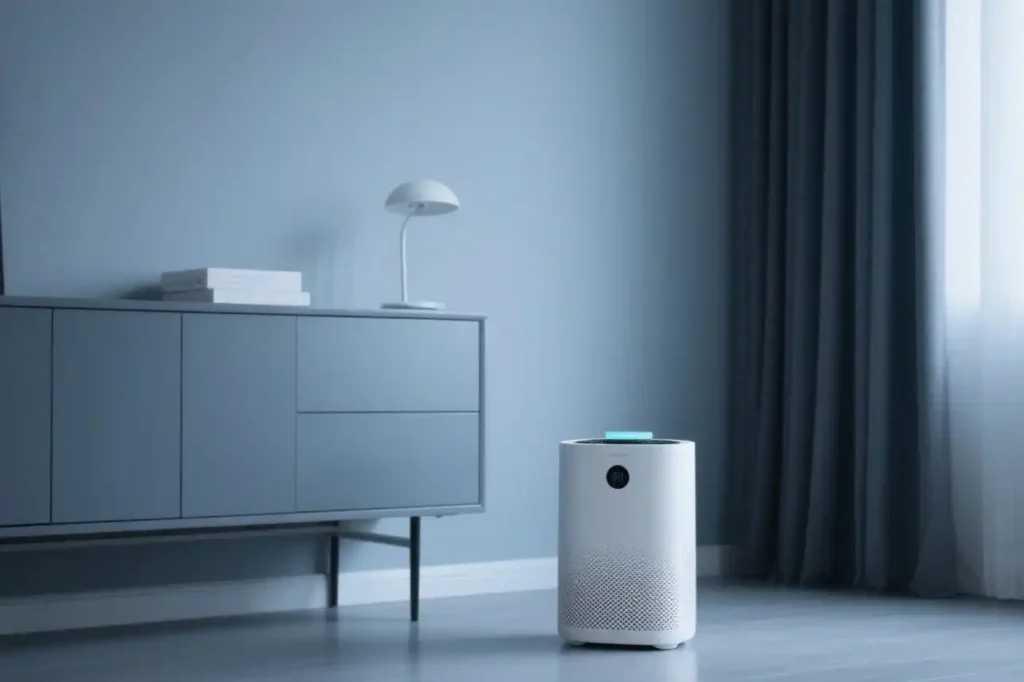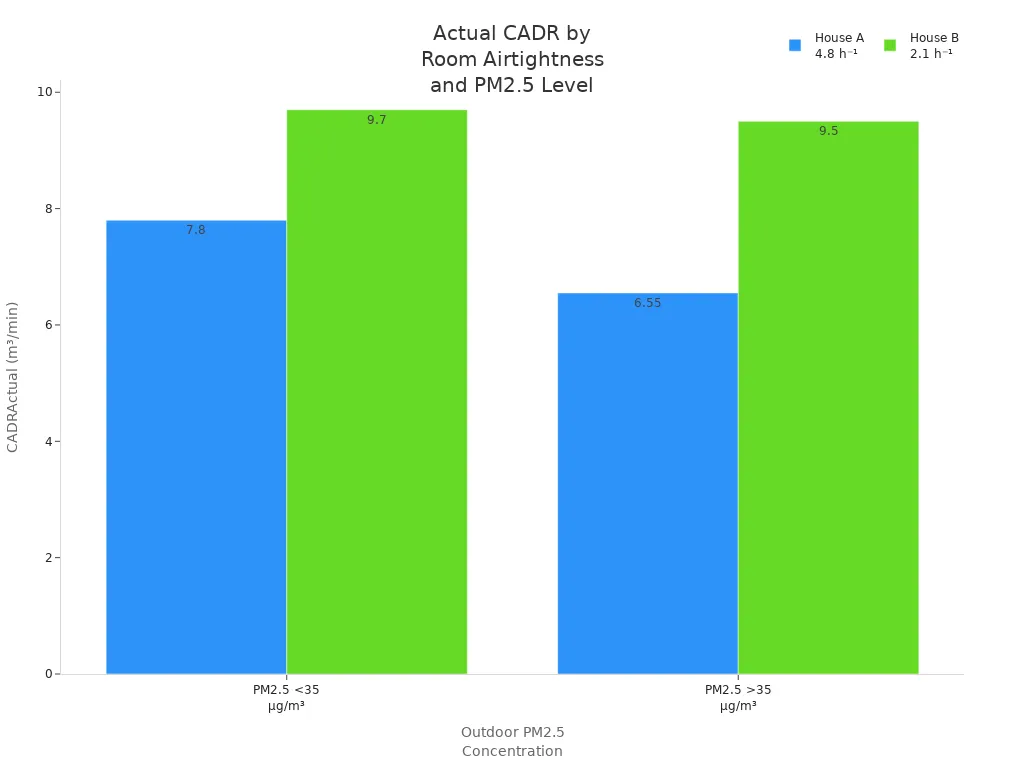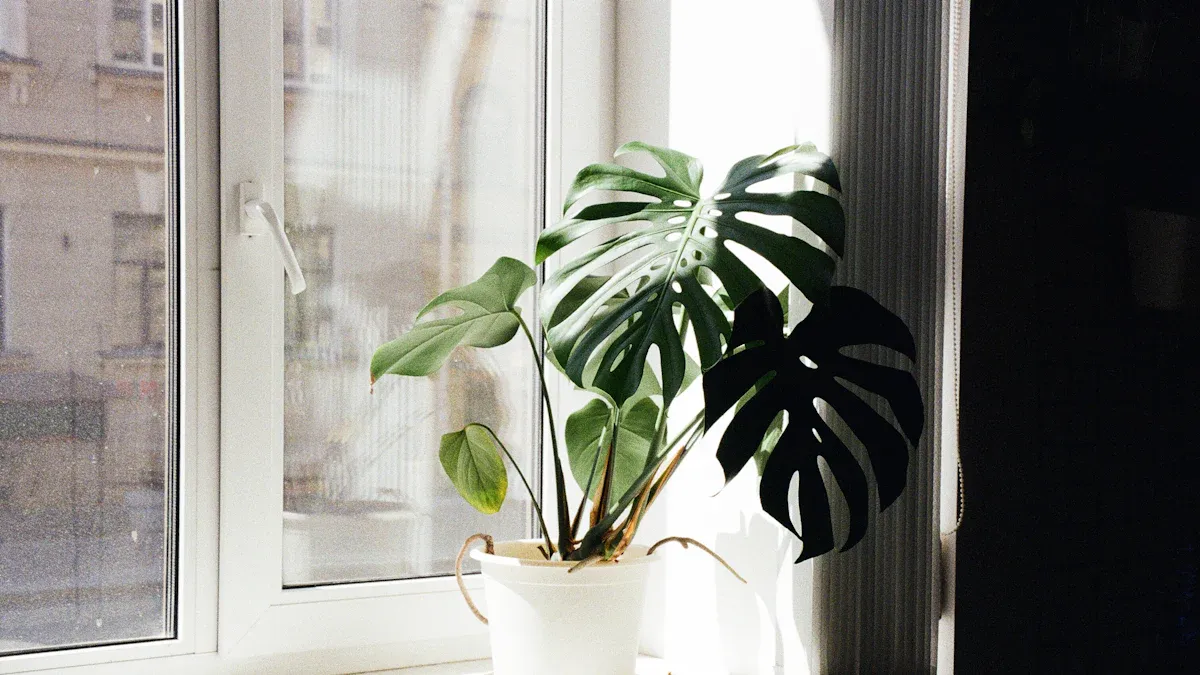
For best results, keep the room closed when the air purifier turned on. Experts recommend closing the bedroom door to create a separate space. With the air purifier turned on, it can clean the air inside more effectively. By preventing outside air from entering, the purifier works faster, removing dust, pollen, and other pollutants more quickly. This way, you get cleaner air in less time.
Key Takeaways
- Keep your room closed when the air purifier is on to help it clean the air faster and better.
- Run your air purifier all day at low settings to maintain fresh air and save energy.
- Open windows briefly each day to bring in fresh air, then close them to let the purifier work well.
- Check and change filters regularly to keep your purifier working at its best.
- Place the purifier away from walls and near pollution sources for faster and more effective cleaning.
Room Closed When Air Purifier Turned On

Why Closed Rooms Work Best
If you keep your room closed, the air purifier works better. The air purifier pulls in dust, pollen, and viruses from the air. When doors and windows are shut, it cleans the same air again and again. This makes the air cleaner each time. The process is faster in a closed room.
Tip: Put your air purifier in the room you use most, like your bedroom. Keep the door closed to get the best results.
Studies show that the air exchange rate in a closed room matters a lot. In one classroom, a HEPA purifier with an air exchange rate of 5.7 per hour lowered virus particles by six times. Scientists use Clean Air Delivery Rate (CADR) to measure how fast a purifier cleans a room. CADR depends on the purifier’s power and how much air moves in and out. If you keep the room closed, the purifier can work its best.
| Factor / Condition | Description / Observation | Effect on CADRActual vs CADRAP |
|---|---|---|
| Airtightness (ACH50) | Poorly sealed room (more leaks) | CADRActual drops to 66-73% of rated value; more outdoor particles enter |
| Well-sealed room | CADRActual stays close to 90% of rated value; less outdoor pollution enters | |
| Outdoor PM2.5 Concentration | Low (<35 μg/m³) | Higher CADRActual; purifier works better |
| High (>35 μg/m³) | CADRActual drops in leaky rooms; stays stable in sealed rooms | |
| Air Purifier Flow Rate | Lower flow rates | Takes longer to clean air; more outdoor particles can enter |
| Effect of Outdoor Wind Speed | High wind increases leaks | More outdoor particles enter, lowering CADRActual |

Room size is important too. Big rooms need more time and a stronger purifier. If your room is large, you might need a purifier with higher CADR or more than one. Keeping the room closed helps the purifier clean all the air.
Preventing Pollutant Entry
Closing doors and windows keeps outdoor pollutants out when the air purifier is on. Research in schools showed that closed rooms had less dust and pollution than open rooms. In one classroom, closing the room and using the purifier removed about 54% of the smallest particles and 25% of the bigger ones. If you open windows, new pollutants come in fast, making it hard for the purifier to keep up.
Note: The American Thoracic Society says to use air purifiers in closed rooms, especially bedrooms, to keep outdoor pollution out and make the air better.
You get the best results if you keep your air purifier on all the time, even when you sleep or leave. Here’s what happens when you do this:
- You keep removing dust, pollen, pet dander, smoke, and germs from the air.
- You help people with allergies or asthma breathe and sleep better.
- You stop pollutants from settling and coming back into the air.
- You deal with sudden pollution, like smoke from cooking or wildfires, right away.
- Most new purifiers are safe and use little energy, so you can run them all day.
To get the cleanest air, keep your air purifier on and your room closed as much as you can. Remember to check and change the filters often, because they fill up faster if you use the purifier all the time.
Open Room Effects

Reduced Efficiency
If you leave your door or window open, outside pollutants can get in. These include particulate matter, carbon dioxide, and volatile organic compounds. Living near a busy road means even more particles come inside. The air purifier tries to clean these, but new pollutants keep entering. This makes the purifier less able to do its job.
- Common pollutants that enter through open windows:
- Particulate matter (PM10, PM2.5)
- Carbon dioxide (CO2)
- Volatile organic compounds (VOCs)
- Viruses carried by dust
HEPA filters can catch many of these, especially the tiny ones. But if the room stays open, the purifier cannot keep up with all the new pollution. Studies in homes show closed windows help air purifiers work better. In classrooms, closing windows and using one air purifier cut virus particles by about half. Using two purifiers worked even better. But the biggest drop, up to 88%, happened when teachers used both open windows and purifiers together.
| Pollutant Type | Ventilation Scenario | Effect on Concentration (%) | Notes |
|---|---|---|---|
| PM10 | Continuous ventilation | Reduced by 14% (near highway classroom) | Outdoor PM10 gets in when windows are open, raising indoor PM10. |
| PM2.5 | Continuous ventilation | Reduced by 7% (near highway classroom) | Fine particles come inside and make the purifier less effective. |
| PM10 | Scheduled ventilation + purifier | Reduced up to 36% | Using both ventilation and a purifier lowers particulate matter and carbon dioxide. |
| CO2 | Scheduled ventilation + purifier | Reduced up to 28% | Carbon dioxide goes up with open windows but can be lowered with scheduled ventilation. |
| PM1 | All ventilation scenarios | No significant change | Very tiny particles (PM1) do not change much with different ventilation. |
Tip: If you need to open a window, do it for a short time. Try scheduled ventilation to help your air purifier work better.
When Ventilation Is Needed
Sometimes you must open your room, even with the air purifier on. Ventilation helps get rid of moisture, carbon dioxide, and bad smells. Without fresh air, you might feel tired or get headaches. Breathing can get harder, and viruses or bacteria can stay longer.
- Why you need ventilation:
- Gets rid of extra moisture and stops mold
- Lowers carbon dioxide so you can think and feel better
- Reduces the chance of getting sick from the air
- Keeps humidity at a healthy level (40%-60%)
Experts say to use air purifiers and also open windows sometimes. Open your windows for a few minutes each day. Then close them and let the purifier clean the air. This way, you get both clean and fresh air.
Note: Air purifiers clean particles and some gases, but not every indoor air problem. You still need to open windows to keep your room healthy.
Maximizing Performance
Continuous Operation
Running your air purifier all day keeps your air clean and healthy. Modern models use little electricity, often less than a light bulb. You can leave them on even when you sleep or leave the house. Smart sensors help by adjusting fan speed based on air quality, so the purifier works harder only when needed. This saves energy and reduces noise. Placing the purifier in an open area, away from walls and corners, helps air flow better. Keep at least 3-4 feet of space around the unit. Put it near pollution sources like doors, windows, or kitchens to catch dust and odors quickly.
Tip: Continuous operation at low settings keeps air fresh and uses less power than turning the unit on and off.
Filter Maintenance
Clean filters help your purifier work its best. Check pre-filters every month and clean them if they look dirty. Replace main filters every 6 to 12 months, or sooner if you use the purifier all the time or live in a dusty area. Some purifiers have lights that tell you when to change filters, but you should also follow the schedule in the manual. If you notice less airflow or strange smells, it may be time for a new filter. High-quality filters last longer and keep your air cleaner.
| Filter Type | Recommended Change Interval | Notes |
|---|---|---|
| Pre-filter | Every 6 months | Clean monthly for best results |
| Main filter (HEPA) | Every 6-12 months | Replace sooner with heavy use |
| VOC/Carbon filter | Every 6 months | Needed more often with odors/smoke |
Note: Dirty filters make the purifier work harder, use more energy, and clean less air.
Noise and Energy Tips
You can keep your room quiet and save money by using the right settings. Lower fan speeds make less noise and use less electricity. Many purifiers have a sleep or night mode for quiet operation. Smart features like auto mode and air quality sensors help balance noise and energy use. Choose a purifier that matches your room size. Using a large purifier in a small room wastes energy, while a small one in a big room cannot clean the air well.
| Fan Speed | Power Use (Watts) | Monthly Cost (USD) | Noise Level (dB) |
|---|---|---|---|
| Sleep | 3.3 | $0.28 | 24–30 |
| Low | 5.8 | $0.50 | 24–40 |
| Medium | 8.8 | $0.77 | 35–45 |
| High | 16.1 | $1.41 | 42–60 |
| Turbo | 35 | $3.06 | 50–60 |
Tip: Place the purifier away from electronics and avoid blocking the vents. This helps reduce noise and keeps energy use low.
When you keep your room closed with the air purifier turned on, you help it clean the air faster and more effectively. Running your purifier every day and following a regular maintenance schedule keeps your air fresh and healthy. Remember to open windows for a few minutes each day to let in fresh air.
For best results, follow these daily tips:
- Place your purifier in the right spot.
- Change filters on time.
- Keep humidity below 60%.
- Clean dust and clutter often.
FAQ
What happens if you run an air purifier with the door open?
You let outside air and pollutants enter the room. The purifier works harder but cannot clean the air as well. You get less clean air and may not see much improvement.
What should you do if your room feels stuffy with the air purifier on?
You can open a window for a few minutes to let in fresh air. After that, close the window and turn the purifier back on. This helps keep the air clean and fresh.
What is the best place to put your air purifier?
Place your air purifier in the center of the room or near pollution sources like doors or windows. Keep it away from walls and furniture. This helps the purifier clean the air faster.
What signs show you need to change the filter?
You may notice less airflow, strange smells, or a warning light on your purifier. Check the filter every month. Replace it if it looks dirty or clogged.
What can you do to keep your air purifier working well?
Clean the pre-filter every month. Change the main filter on time. Run the purifier every day. Keep the room closed as much as possible. Dust and vacuum your room often.
See also
Which Is Better for Your Health: Humidifier or Air Purifier
Best Intelligent Air Purifiers with Air Quality Monitors You Can Buy
Air Purifier vs. Humidifier: Best for Infants and Sinus Relief?
Air Purifiers vs. Humidifiers: What to Know for Asthma and Allergies
